-
Countries
-
Data and Analysis
-
Special Focus
-
Crisis Responses

Contact
DTM Europe, DTMMediterranean@iom.int
Language
English
Location
Republic of Türkiye
Period Covered
Oct 01 2022
Oct 31 2022
Activity
- Flow Monitoring
- Migrants presence
- Mobility Tracking
According to the latest available figures from the Turkish Presidency of Migration Management (PMM), there are more than 4.9* million foreign nationals present in Turkish territory, 3.6* million of whom are seeking international protection. Most are Syrians (3,603,724* individuals) who are granted temporary protection status. In addition, international protection applicants from countries including Afghanistan, the Islamic Republic of Iran and Iraq constitute another group of foreign nationals. According to PMM, there were 29,256* international protection applicants present in Türkiye in 20211, published annually. Moreover, according to UNHCR**,
there are close to 330,000 international protection status holders and asylum-seekers. The number of foreign nationals has decreased by 124,560 in comparison to October 2021 (3.7 million foreign nationals).
In addition, there are 1,336,601* foreign nationals present in Türkiye holding residency permits, including humanitarian residency holders. Compared to October 2021, this is an increase of 94,757 individuals. The exact number of humanitarian residency holders is
unknown, but it is estimated that there are more than several thousand humanitarian residency permit holders.
*Data source PMM, 03.11.2022
**Data source UNHCR, July 2022

Contact
DTM Europe, DTMMediterranean@iom.int
Language
English
Location
Republic of Türkiye
Period Covered
Oct 01 2022
Oct 31 2022
Activity
- Flow Monitoring
- Migrants presence
- Mobility Tracking
According to the latest available figures from the Turkish Presidency of Migration Management (PMM), there are more than 4.9* million foreign nationals present in Turkish territory, 3.6* million of whom are seeking international protection.
Most of those seeking international protection are Syrians (3,603,724* individuals) who are granted the temporary protection status in Türkiye. In addition, international protection applicants are most frequently nationals of Afghanistan, the Islamic Republic of Iran and Iraq constitute another group of foreign nationals. According to PMM, there were 29,256* international protection applicants present in Türkiye in 20211, published annually. Moreover, according to UNHCR**, there are close to 330,000 international protection status holders and asylum-seekers.
In addition, there are 1,336,601* foreign nationals under residence permit holder status; this number includes humanitarian residence holders.
*Data Source PMM, 03.11.2022
**Data source UNHCR, July 2022

Contact
DTM Nigeria, AllUsersInDTMNigeria@iom.int
Language
English
Location
Nigeria
Period Covered
Oct 28 2022
Nov 01 2022
Activity
- Event Tracking
The rainy season in Nigeria typically occurs annually with the greatest concentration of precipitation between the months of June and September. Many states in Nigeria have been affected by unprecedented heavy rainfalls and floods have devastated various communities. Infrastructure, crops, and shelters have been damaged which led to decimated livelihoods and the displacement of numerous households. Over the past months, climate variability and the release of excess water from the Lagdo dam in northern Cameroon, have worsened the flood situation and has resulted in a renewed situation of widespread displacement across Nigeria.
Between 28 October and 1 November 2022, DTM, in collaboration with the National Emergency Management Agency (NEMA), the Anambra State Emergency Management Agency (ASEMA) and the Nigerian Red Cross Society (NCRS) identified 36 locations in Anambra State that were affected by the floods and/or received IDPs that are currently displaced as a result of the floods.˝ Through a network of 95 key informants and field focal points and in close coordination with other humanitarian partners and local authorities on ground, DTM conducted assessments in these locations to inform the humanitarian community on the main needs, vulnerabilities and mobility intentions of the affected population.
In the seven (7) Local Government Areas (LGAs) of Anambra state assessed, DTM identified 35,074 individuals in 6,980 households that were affected by the floods. These individuals included both IDPs that were living in camp-like settings and residents who were impacted by the floods but remained in their communities.
Contact
iomyemendtm@iom.int
Location
Yemen
Activity
- Flow Monitoring
Period Covered
Oct 01 2022 -Oct 31 2022
In October 2022, IOM Yemen DTM recorded 6,381 migrants entering Yemen, an six per cent increase compared to September 2022 (6,041). In Lahj DTM has registered an increase in arrivals (+ 60%) compared to the last month in contrast to Shabwah, which registered a decrease this month (- 31%). The overall increase could be linked to weather conditions, sea tides and decreased coast guard patrolling in Djibouti. While travel had been primarily due to economic reasons in the first half of the year, DTM has been recording conflict induced movements since August, being the reason for 35 per cent of all incoming movements in October. All conflict motivated travel was recorded in Shabwah coming from Bari, Somalia (28% children, 21% women and 51% men).
Due to the deteriorating humanitarian crisis in Yemen and the challenges in moving towards KSA, many migrants opted to return to the Horn of Africa. DTM teams in Djibouti recorded that during October 2022, a total of 648 migrants took the risky return by boat from Yemen to travel home. Moreover, DTM recorded 5,454 Yemeni returns from KSA during the month of October 2022, compared to 4,532 in September 2022. Between 1 January and 31 October 2022, DTM recorded 53,401 migrants and 55,269 Yemeni migrant returnees to Yemen.
The migrant caseload was around 96 per cent Ethiopian nationals, and around four per cent Somali nationals. The migrants are predominantly male (64%), with (23%) women, seven per cent boys and six per cent girls also among the travelers.
Through September’s reporting period, 2,502 migrants arrived from Somalia and were recorded 1,957 at Ber Ali, 325 at Araqah and 218 at Eyn Bamabad flow monitoring points in Shabwah governorate. In Lahj governorate, 3,876 migrants arrived from Djibouti, where 3,101 were recorded at Al Makhabbah flow monitoring point (FMP), 407 at Al Cawhah FMP, 159 at Hasy Eisa FMP, 101 at Al-Batin FMP, 88 at Al Azaf FMP, and 20 at Al Hejaf FMP.
Population Groups
Survey Methodology
Unit of Analysis Or Observation
Type of Survey or Assessment
Keywords
Geographical Scope
Administrative boundaries with available data
The current dataset covers the following administrative boundaries
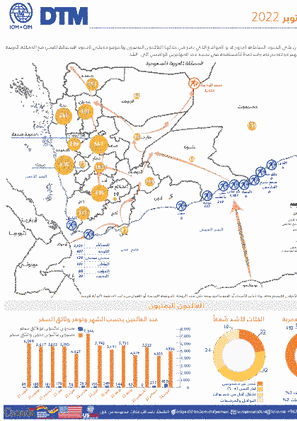
Contact
DTM Yemen, iomyemendtm@iom.int
Language
Arabic
Location
Yemen
Period Covered
Oct 01 2022
Oct 31 2022
Activity
- Flow Monitoring
في اكتوبر 2022 ، سجلت مصفوفة تتبع النزوح (DTM) التابعة للمنظمة الدولية للهجرة في اليمن 6,381 مهاجرًا دخلوا اليمن ،بزيادة قدرها (%6) مقارنة بـ 6,041 مهاجرًا في سبتمبر 2022. سجلت مصفوفة تتبع النزوح في محافظة لحج زيادة في عدد الوافدين (60+%) مقارنة بالشهر الماضي على عكس شبوة التي شهدت انخفاضاً هذا الشهر (31-%). ويمكن ربط الزيادة العام بالأحوال الجوية والمد البحري وانحفاض دوريات خفر السواحل في جيبوتي. في حين أن الهحرة كانت في المقام الأول لأسباب اقتصادية في النصف الأول من العام ، فإن مصفوفة تتبع النزوح كانت تسجل الصراع منذ أغسطس ، على انه السبب وراء 35 في المائة من جميع التحركات الواردة في أكتوبر. تم تسجيل جميع رحلات السفر بدافع الصراع في شبوة قادمة من باري ، الصومال (28٪ أطفال ، 21٪ نساء و 51٪ رجال).
بسبب الأزمة الإنسانية المتدهورة في اليمن والتحديات في المضي قدمًا نحو المملكة العربية السعودية ، اختار العديد من المهاجرين العودة إلى القرن الأفريقي. حيث سجلت فرق مصفوفة تتبع النزوح في جيبوتي خلال اكتوبر 2022 ، خوض 648 مهاجراً رحلة العودة الخطرة على متن قوارب من اليمن. بالإضافة إلى ذلك ، سجلت مصفوفة تتبع النزوح في اليمن حوالي 5,454 يمني عادوا من المملكة العربية السعودية خلال شهر اكتوبر، مقارنة بـ 4,532 في سبتمبر 2022. خلال الفترة بين 1 يناير و 31 اكتوبر 2022، وصل ما يقدر بـ 53,401 مهاجرًا و 55,269 يمنيًا عائداً إلى اليمن.
حيث مثل عدد المهاجرين من إثيوبيا96 % في المائة و اربعة في المائة من الصوماليين. كانت غالبية المهاجرين من الذكور (64) مع (23%) من النساء ، و سبعة في المائة من الأولاد وستة في المائة من الفتيات اللواتي كنا ايضاً من ضمن المسافرين.
خلال فترة التقرير في اكتوبر 2022، شوهد وصول 2,876 مهاجرا من الصومال وتم تسجيلهم في نقاط مراقبة التدفق في محافظة شبوه حيث سجل عدد 1,9587 في بئر علي و ا 325 في عرقة. بينما شهدت نقاط مراقبة التدفق بمديرية المضاربة والعارة بمحافظة لحج وصول 3,876 مهاجرا وصلوا من جيبوتي , حيث تم تسجيل 3,101 في المخابأه ؛ وا 407 في الكوحه ؛ وا 159 في حسي عيسى ؛ وا 101 في الباطن ؛ وا 88 في العزاف وا 20 في الحجيف.
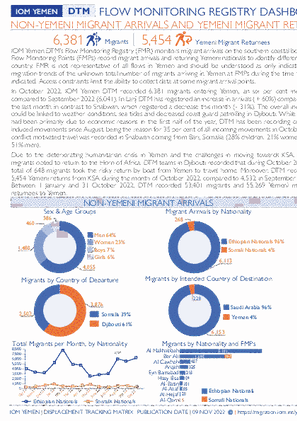
Contact
DTM Yemen, iomyemendtm@iom.int
Language
English
Location
Yemen
Period Covered
Oct 01 2022
Oct 31 2022
Activity
- Flow Monitoring
In October 2022, IOM Yemen DTM recorded 6,381 migrants entering Yemen, an six per cent increase compared to September 2022 (6,041). In Lahj DTM has registered an increase in arrivals (+ 60%) compared to the last month in contrast to Shabwah, which registered a decrease this month (- 31%). The overall increase could be linked to weather conditions, sea tides and decreased coast guard patrolling in Djibouti. While travel had been primarily due to economic reasons in the first half of the year, DTM has been recording conflict induced movements since August, being the reason for 35 per cent of all incoming movements in October. All conflict motivated travel was recorded in Shabwah coming from Bari, Somalia (28% children, 21% women and 51% men).
Due to the deteriorating humanitarian crisis in Yemen and the challenges in moving towards KSA, many migrants opted to return to the Horn of Africa. DTM teams in Djibouti recorded that during October 2022, a total of 648 migrants took the risky return by boat from Yemen to travel home. Moreover, DTM recorded 5,454 Yemeni returns from KSA during the month of October 2022, compared to 4,532 in September 2022. Between 1 January and 31 October 2022, DTM recorded 53,401 migrants and 55,269 Yemeni migrant returnees to Yemen.
The migrant caseload was around 96 per cent Ethiopian nationals, and around four per cent Somali nationals. The migrants are predominantly male (64%), with (23%) women, seven per cent boys and six per cent girls also among the travelers.
Through September’s reporting period, 2,502 migrants arrived from Somalia and were recorded 1,957 at Ber Ali, 325 at Araqah and 218 at Eyn Bamabad flow monitoring points in Shabwah governorate. In Lahj governorate, 3,876 migrants arrived from Djibouti, where 3,101 were recorded at Al Makhabbah flow monitoring point (FMP), 407 at Al Cawhah FMP, 159 at Hasy Eisa FMP, 101 at Al-Batin FMP, 88 at Al Azaf FMP, and 20 at Al Hejaf FMP.

Contact
DTMAfghanistan@iom.int
Language
English
Location
Afghanistan
Period Covered
Oct 16 2022
Oct 31 2022
Activity
- Flow Monitoring
The snapshot captures present mobility and displacement trends between Afghanistan, the Islamic Republic of Iran and Pakistan.
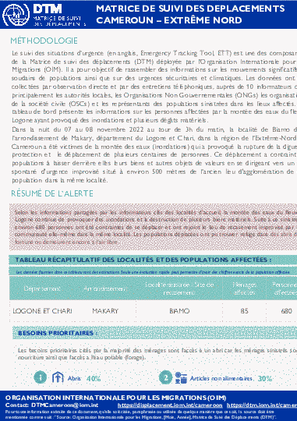
Contact
DTM Cameroon, DTMCameroun@iom.int
Language
French
Location
Cameroon
Period Covered
Nov 07 2022
Nov 08 2022
Activity
- Mobility Tracking
- Event Tracking
Le suivi des situations d’urgence (en anglais, Emergency Tracking Tool, ETT) est une des composantes de la Matrice de suivi des déplacements (DTM) déployée par l’Organisation Internationale pour les Migrations (OIM). Il a pour objectif de rassembler des informations sur les mouvements significatifs et soudains de populations ainsi que sur des urgences sécuritaires et climatiques. Les données ont été collectées par observation directe et par des entretiens téléphoniques, auprès de 10 informateurs clés, principalement les autorités locales, les Organisations Non Gouvernementales (ONGs) les organisations de la société civile (OSCs) et les représentants des populations sinistrées dans les lieux affectés. Ce tableau de bord présente les informations sur les personnes affectées par la montée des eaux du fleuve Logone ayant provoqué des inondations et plusieurs dégâts matériels.
Dans la nuit du 07 au 08 novembre 2022 au tour de 3h du matin, la localité de Biamo dans l’arrondissement de Makary, département du Logone et Chari, dans la région de l’Extrême-Nord du Cameroun a été victimes de la montée des eaux (inondations) qui a provoqué la rupture de la digue de protection et le déplacement de plusieurs centaines de personnes. Ce déplacement a contraint les populations à laisser derrière elles leurs biens en se dirigeant vers un site spontané d'urgence improvisé situé à environ 500 mètres de l’ancien lieu d'agglomération de ces population dans la même localité.
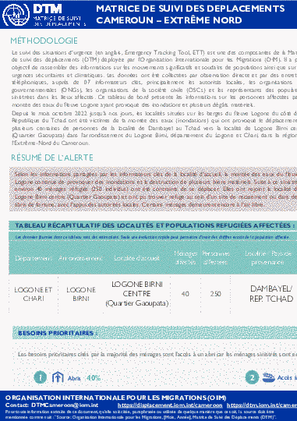
Contact
DTM Cameroon, DTMCameroun@iom.int
Language
French
Location
Cameroon
Period Covered
Nov 07 2022
Nov 08 2022
Activity
- Mobility Tracking
- Event Tracking
Le suivi des situations d’urgence (en anglais, Emergency Tracking Tool, ETT) est une des composantes de la Matrice de suivi des déplacements (DTM) déployée par l’Organisation Internationale pour les Migrations (OIM). Il a pour objectif de rassembler des informations sur les mouvements significatifs et soudains de populations ainsi que sur des urgences sécuritaires et climatiques. Les données ont été collectées par observation directe et par des entretiens téléphoniques, auprès de 07 informateurs clés, principalement les autorités locales, les organisations non gouvernementales (ONGs), les organisations de la société civile (OSCs) et les représentants des populations sinistrées dans les lieux affectés. Ce tableau de bord présente les informations sur les personnes affectées par la montée des eaux du fleuve Logone ayant provoqué des inondations et plusieurs dégâts matériels.
Depuis le mois octobre 2022 jusqu’à nos jours, les localités situées sur les berges du fleuve Logone du côté de la République du Tchad ont été victimes de la montée des eaux (inondations) qui ont provoqué le déplacement de plusieurs centaines de personnes de la localité de Dambayel au Tchad vers la localité de Logone Birni centre (Quartier Gaoupata) dans l’arrondissement du Logone Birni, département du Logone et Chari, dans la région de l’Extrême-Nord du Cameroun.
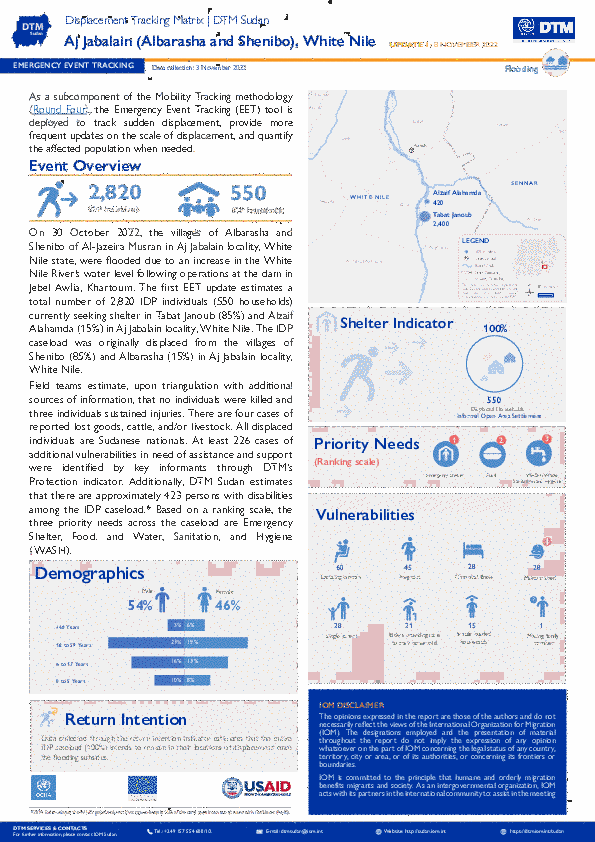
Contact
DTM Sudan; dtmsudan@iom.int
Language
English
Location
Sudan
Snapshot Date
Nov 03 2022
Activity
- Mobility Tracking
- Event Tracking
The DTM Emergency Event Tracking (EET) is deployed to track sudden displacement and population movements, provide more frequent updates on the scale of displacement, and quantify the affected population when needed. As a subcomponent of the new Mobility Tracking methodology in Sudan (Round Four), and activated on a need basis, EET utilises a broad network of key informants to capture best estimates of the affected population presence per location – a useful tool for humanitarian response planning and design.
